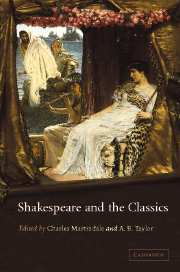Book contents
- Frontmatter
- Contents
- Notes on contributors
- List of abbreviations
- Introduction
- PART I AN INITIAL PERSPECTIVE
- PART II ‘SMALL LATINE’
- 2 Petruchio is ‘Kated’: The Taming of the Shrew and Ovid
- 3 Ovid's myths and the unsmooth course of love in A Midsummer Night's Dream
- 4 Shakespeare's learned heroines in Ovid's schoolroom
- 5 Shakespeare and Virgil
- 6 Shakespeare's reception of Plautus reconsidered
- 7 Shakespeare, Plautus, and the discovery of New Comic space
- 8 ‘Confusion now hath made his masterpiece’: Senecan resonances in Macbeth
- 9 ‘These are the only men’: Seneca and monopoly in Hamlet 2.2
- PART III ‘LESSE GREEK’
- PART IV THE RECEPTION OF SHAKESPEARE'S CLASSICISM
- Select bibliography (compiled by Joanna Paul)
- Index
3 - Ovid's myths and the unsmooth course of love in A Midsummer Night's Dream
Published online by Cambridge University Press: 22 September 2009
- Frontmatter
- Contents
- Notes on contributors
- List of abbreviations
- Introduction
- PART I AN INITIAL PERSPECTIVE
- PART II ‘SMALL LATINE’
- 2 Petruchio is ‘Kated’: The Taming of the Shrew and Ovid
- 3 Ovid's myths and the unsmooth course of love in A Midsummer Night's Dream
- 4 Shakespeare's learned heroines in Ovid's schoolroom
- 5 Shakespeare and Virgil
- 6 Shakespeare's reception of Plautus reconsidered
- 7 Shakespeare, Plautus, and the discovery of New Comic space
- 8 ‘Confusion now hath made his masterpiece’: Senecan resonances in Macbeth
- 9 ‘These are the only men’: Seneca and monopoly in Hamlet 2.2
- PART III ‘LESSE GREEK’
- PART IV THE RECEPTION OF SHAKESPEARE'S CLASSICISM
- Select bibliography (compiled by Joanna Paul)
- Index
Summary
THESEUS AND HIPPOLYTA AND THE PLAY'S OPENING
The moonlight and rich poetry at the opening of A Midsummer Night's Dream tend to overshadow the fact that Shakespeare's marriage play also ironically opens in the wake of a full-scale war between the sexes in which women, the legendary Amazons, have been beaten by the men of the Athenian army. But the savagery of war having given way to the ‘gentle concord’ of love, the newly discovered harmony is epitomised in the coming union of the leaders of the opposing sides. And as he and his bride-to-be await their wedding day, resolving to wed her ‘in another key’, Theseus remarks on the strangeness of their coming together:
Hippolyta, I woo'd thee with my sword,
And won thy love doing thee injuries
(1.1.16–17)These lines would have met with the approval of an Elizabethan audience imbued with patriarchal values: rebellious and disruptive womanhood, in the person of a warrior queen who had tried to overthrow one of the oldest civilisations, has been forced to submit to the ‘natural’ order and is in the process of being returned to the civilised fold through marriage. And, unusual as are the circumstances that occasion them, these lines contain a pattern found in some outstanding Elizabethan writing on courtship: of peace and harmony achieved in a relationship only after conflict in which there is violence and aggression on the man's part (the evocative image of the sword) and pain and suffering on the woman's (the equally evocative image of the wounding).
- Type
- Chapter
- Information
- Shakespeare and the Classics , pp. 49 - 65Publisher: Cambridge University PressPrint publication year: 2004
- 2
- Cited by



